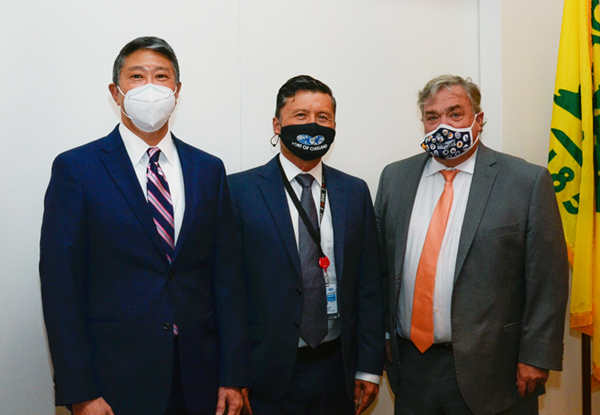
Port of Oakland executives recently discussed collaboration and transparency with Federal Maritime Commissioner Carl Bentzel and California State Transportation Agency Secretary David Kim. The pair joined nearly two dozen shipping leaders at the end of August for a roundtable on Oakland’s future as a global trade gateway.
Port officials stated public/private sector collaboration would be key to strengthening Oakland’s place in the global supply chain and to strengthen the state and federal economies. It asked for support from maritime leaders to streamline seaport operations and collaborate on making the supply chain transparent for customers and operators.
“Together we can build on trends for increased cargo capacity that are placing Oakland in the spotlight,” Port of Oakland Executive Director Danny Wan said. “The opportunity is here, if we can agree to seize it.”
The port said Oakland is breaking containerized cargo handling records amidst an unprecedented U.S. import surge. The boom in volume could be permanent, the port added, due to factors that include:
- Oakland’s improved ability to handle the world’s largest container ships;
- Northern California’s rise as a center for e-commerce distribution; and
- The port’s proximity to one of the predominant agricultural regions of the U.S., California’s Central Valley.
Port officials have said that shipping lines increasingly view Oakland as “an essential gateway” in the U.S.-Asia trade, citing as evidence the fact that three ocean carriers have launched first-call Oakland services in 2021, thus becoming where vessels from Asia make their first North America stops. Most U.S. imports are discharged at first-call ports.
Port officials told attendees of the Aug. 30 roundtable that increased business has created new jobs in the transportation and logistics sectors. Growth has also posed operational challenges in Oakland, the port added, saying that there’s a scramble to keep up with the surge in container volume.
That’s where collaboration comes in, the port explained.
Port officials lauded marine terminal operators who’ve invested millions to update their operations and equipment, but added that more would be needed for big-ticket items such as ship-to-shore cranes.
The port has asked continued fiscal support from government to finance sustainable transportation initiatives to ensure a transition into zero-emissions cargo operations. It called on waterfront labor and management to continue working together to ensure a skilled workforce to keep operations fluid and cargo moving.
“Ports are essential to the U.S. economy, and just as essential is how they operate,” Bentzel remarked. “Operational discussions like this are critical to strengthening our supply chain and improving efficiency to meet current and post-pandemic cargo demand.”
“California’s ports serve as the gateway to the freight world – where cargo is transferred and distributed through the state to the rest of the nation,” added California State Transportation Agency Secretary David Kim. “As our ports play a major role in economic vitality and environmental stewardship, I’m pleased to join with our federal partners, the Port of Oakland and its operators, shippers and beneficial cargo owners to discuss what’s needed to maintain and increase competitiveness.”
Prior to the COVID-19 pandemic, the Port of Oakland and its business partners supported more than 84,000 jobs in the region and more than a million related jobs across the country, according to a Martin Associates economic impact study.
Locally, activity at the port’s business lines spurs $12.9 billion in yearly economic impact and generates $698 million in annual local taxes, Oakland data show. Also, cargo activity at the seaport and Oakland International Airport generates a financial output of more than $117 billion a year, according to the port.

